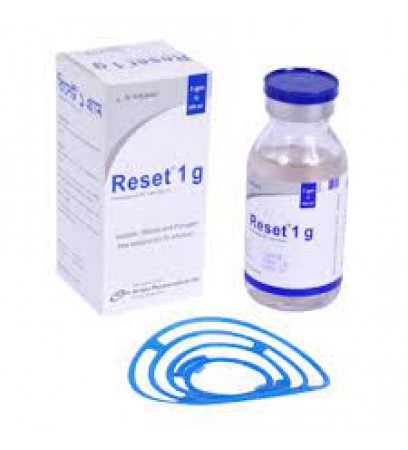Reset - IV 100 ml
- Brand:Incepta Pharmaceuticals Ltd
- Product Code: Paracetamol 10mg/ml
- Availability: In Stock
-
114.00Tk.
Generic
Paracetamol [IV Infusion]
Indications
The use of paracetamol IV for the treatment of mild to moderate pain, the treatment of moderate to severe pain with supplementary opioid analgesics, and the treatment of fever is recommended.
Pharmacology
Paracetamol has analgesic and antipyretic properties and its anti-inflammatory activity is weak. Paracetamol (acetaminophen) is believed to act primarily on the central nervous system, increasing pain threshold by inhibiting the two isomers of cyclooxygenase COX1, COX2 and COX3 that are involved in prostaglandin (PG) synthesis. Paracetamol is a derivative of p-aminophenol, which has analgesic and antipyretic effects, and has a weak anti-inflammatory activity. Paracetamol is one of the most widely used, safest, and fast-acting pain relievers. It is well tolerated and does not have the various side effects of aspirin.
Tramadol is a centrally acting synthetic opioid analgesic. Although its mode of action is not fully understood, from animal experiments, at least two complementary mechanisms seem to be applicable: maternal metabolites and the binding of M1 to μ-opioid receptors and weak reuptake of norepinephrine and serotonin Restrain. The opioid activity is due to the low-affinity binding of the parent compound and the high-affinity binding of the Odemethylated metabolite M1 to the μ opioid receptor. Like some other opioid analgesics, tramadol has been shown to inhibit the reuptake of norepinephrine and serotonin in vitro. These mechanisms may independently affect the overall analgesic effect of tramadol.
Dosage & Administration
Adults and adolescents weighing 50 kg and over: the recommended dosage of Paracetamol IV is 1000 mg every 6 hours or 650 mg every 4 hours, with a maximum single dose of Paracetamol IV of 1000 mg, a minimum dosing interval of 4 hours, and a maximum daily dose of Paracetamol of 4000 mg per day.
Adults and adolescents weighing under 50 kg: the recommended dosage of Paracetamol IV is 15 mg/kg every 6 hours or 12.5 mg/kg every 4 hours, with a maximum single dose of Paracetamol IV of 15 mg/kg, a minimum dosing interval of 4 hours, and a maximum daily dose of Paracetamol of 75 mg/kg per day.
Children >2 to 12 years of age: the recommended dosage of Paracetamol IV is 15 mg/kg every 6 hours or 12.5 mg/kg every 4 hours, with a maximum single dose of Paracetamol IV of 15 mg/kg, a minimum dosing interval of 4 hours, and a maximum daily dose of Paracetamol of 75 mg/kg per day.
Interaction
Barbiturates, tricyclic antidepressants, and alcohol may impair the capacity of patients to metabolize large doses of paracetamol. Overdosing on paracetamol can cause hepatotoxicity if used with alcohol. Anticonvulsants and oral steroid contraceptives cause liver enzymes to increase, which may prevent therapeutic Paracetamol levels from being reached by increasing first-pass metabolism or clearance.
Contraindications
Patients with known allergy to the active component or any of the excipients in the intravenous formulation should avoid taking paracetamol. Patients with significant hepatic impairment or active liver disease should not use this medication.
Side Effects
Adverse medication responses, like other paracetamol products, are extremely rare (>1/10000, 1/1000) or very rare (1/10000). During clinical studies, many adverse responses at the injection site were recorded (pain and burning sensation). Hypersensitivity responses ranging from simple skin rash or urticaria to anaphylactic shock have been documented in extremely rare situations, necessitating treatment cessation. There have been reports of erythema, flushing, pruritus, and tachycardia.
Pregnancy & Lactation
Pregnancy category C. There are no studies on intravenous paracetamol in pregnant women; however, epidemiological data on the use of oral acetaminophen in pregnant women do not show an increased risk of severe congenital malformations. Animal reproduction studies on intravenous paracetamol have not been conducted, and it is not clear whether intravenous paracetamol can cause fetal harm to pregnant women. Pregnant women should be given intravenous paracetamol only if it is clearly needed. There are no adequate and well-controlled studies of intravenous injection of paracetamol during childbirth; therefore, it can only be used in such settings after careful benefit-risk assessment. Although the study of intravenous paracetamol has not been conducted, a small amount of paracetamol is secreted into breast milk after oral administration.
Precautions & Warnings
Taking paracetamol higher than the recommended dose can cause liver damage, including the risk of severe liver toxicity and death. Do not exceed the maximum recommended daily dose of acetaminophen. Be careful when using acetaminophen in patients with the following diseases: liver failure or active liver disease, alcoholism, chronic malnutrition, severe hypovolemia (for example, due to dehydration or blood loss), or severe renal failure (creatinine Clearance rate <; 30 ml/min). ). There are rare reports of life-threatening allergic reactions that require urgent medical attention. If you experience symptoms related to allergies or hypersensitivity reactions, stop intravenous paracetamol immediately. Patients who are allergic to paracetamol should not use paracetamol IV.
Therapeutic Class
Non opioid analgesics
Storage Conditions
Store in a cool & dry place & away from children. For single use only. The product should be used within 6 hours after opening. Do not refrigerate or freeze.
Pharmaceutical Name
Incepta Pharmaceuticals Ltd.
Tags: Reset - IV 100 ml

